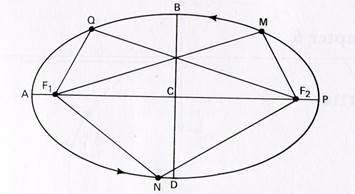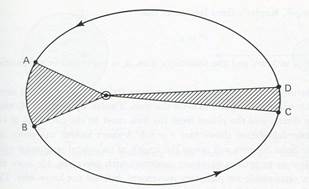The general characteristics of Solar system
| Sun Planets Moon | Mean Radius, km | Average Distance to the Sun, million km | Period of revolution along the orbit | Mass, kg |
| Sun | 695 000 | - | 275 million years | 1.98·1030 |
| Mercury | 2 440 | 57.9 | 88 twenty-four-hours | 3.28·1023 |
| Venus | 6 129 | 108.2 | 224.7 “ “ “ | 4.83·1024 |
| Earth | 6 378 | 149.6 | 365.26 “ “ “ | 5.98·1024 |
| Mars | 3 387 | 227.9 | 687 “ “ “ | 6.37·1023 |
| Jupiter | 71 400 | 778.3 | 11.86 years | 1.90·1027 |
| Saturn | 60 000 | 29.46 “ | 5.67·1026 | |
| Uranus | 25 900 | 84.01 “. | 8.80·1025 | |
| Neptune | 24 750 | 164.8 “ | 1.03·1026 |
The mean distance of the Earth from the Sun, approximately 149,6 million kilometers or 93 million miles, is named astronomical unit. Abbreviation is AU. AU is a unit of length applied in Solar system.
All the numerals presented in the Table are not constants. Only with definite accuracy they characterize our world built with definite regularity but eternally altering.
All elements of solar system are in constant movement. Quite naturally that the exploration of the solar system caused the discovery of kinematic laws, that are known under the name of J. Kepler, who on the base of astronomical observations of Tycho Brahe created the clear and rigorous mathematical construction - the laws of J. Kepler.
The first law.Every planet moves in an ellipse and in one of its focus the Sun is located.

An ellipse is a closed curve for which the sum of distances from all points on the curve to two interior points F1 and F2, each named a focus, is constant. F1 and F2 are foci and MF1 + MF2 = NF1 + NF2 = QF1 + QF2 and so on..
The size of the ellipse is given by the semimajor axis. of the terrestrial orbit around the Sun. . CP = CA = a is the average solar distance? i.e. AU.
The shape, or degree of flattening , is given by eccentricity, the ratio of the distance from the center to the focus (CF1 or CF2) divided by a, i.e. e = CF1/CA = CF2/CA.
If the two foci are brought together at the center , the ellipse reduces to a circle, CF1 is zero, and e = 0.
All ellipses have eccentricities between 0 and 1.
The eccentricity of our orbit is quite low, only 0.0167.
If the ellipse is a planetary orbit, the Sun is at one focus for all planets and the other is an unimportant empty point in space.
If the Sun is at F2 then P is perihelion, the point of closest approach of the Earth to the Sun. A is aphelion, the point in an . elliptical orbit around the Sun that is farthest from the Sun centre.
The Earth passes perihelion about January 5, and aphelion about July 5.
The changing distance gives rise to a variation in the Earth’s orbital velocity. The greatest speed (30.4 kilometers per second ) occurs at perihelion in January and the smallest (29.4 kilometers per second) at aphelion.
The obvious result of the irregular motion of the Earth is the inequality of the seasons.
The second law.The radius-vector between the Sun and planet covers the equal areas ∆S during equal time intervals ∆t. In essence we receive a kinematic constant for the solar system
∆S/∆t = const. (2.7)

Sometimes this law is called as the law of equal areas.
The third law.The square of the orbital period of each planet in years is proportional to the cube of the semimajor axis of the planet’s orbit, i.e. to the cube of its mean distance from the Sun, i.e.
R3/T2 = const, (
where R is the average radius of the orbit of the planet and is calculated as arithmetic mean of the maximum and minimum its distances from the Sun. T is a period of planet revolution around the Sun.
The laws of Johann Kepler are the kinematic base for the Solar system. Really these laws are only kinematic because they describe the movement of planets without any explanation of the causes of their movement.
These laws permit to predict the position of the planet in one or another moment of time, but not more. The base for this kinematic model of the Solar system is the heliocentric conception of Nikolai Kopernik.